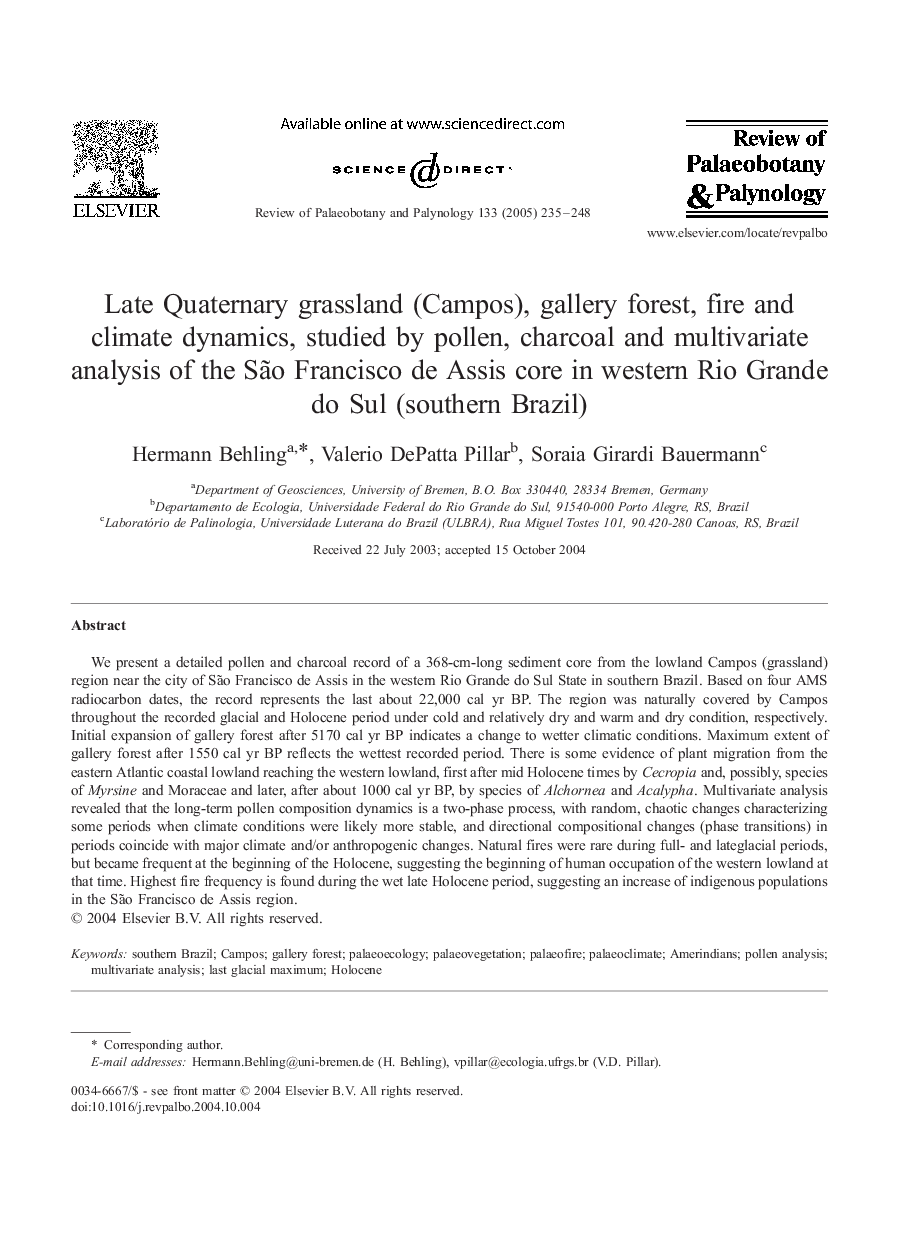| کد مقاله | کد نشریه | سال انتشار | مقاله انگلیسی | نسخه تمام متن |
|---|---|---|---|---|
| 10122112 | 1642596 | 2005 | 14 صفحه PDF | دانلود رایگان |
عنوان انگلیسی مقاله ISI
Late Quaternary grassland (Campos), gallery forest, fire and climate dynamics, studied by pollen, charcoal and multivariate analysis of the São Francisco de Assis core in western Rio Grande do Sul (southern Brazil)
دانلود مقاله + سفارش ترجمه
دانلود مقاله ISI انگلیسی
رایگان برای ایرانیان
کلمات کلیدی
PalaeovegetationpalaeofireLast glacial maximum - آخرین حداکثر یخبندانAmerindians - آمریکایی هاPollen analysis - تجزیه و تحلیل گردهMultivariate analysis - تحلیل چندمتغیرهSouthern Brazil - جنوب برزیلGallery forest - جنگل گالریCampos - زمینه هاHolocene - هولوسنPalaeoclimate - پائئوسکلیماتPalaeoecology - پالایئوکولوژی
موضوعات مرتبط
مهندسی و علوم پایه
علوم زمین و سیارات
فسیل شناسی
پیش نمایش صفحه اول مقاله

چکیده انگلیسی
We present a detailed pollen and charcoal record of a 368-cm-long sediment core from the lowland Campos (grassland) region near the city of São Francisco de Assis in the western Rio Grande do Sul State in southern Brazil. Based on four AMS radiocarbon dates, the record represents the last about 22,000 cal yr BP. The region was naturally covered by Campos throughout the recorded glacial and Holocene period under cold and relatively dry and warm and dry condition, respectively. Initial expansion of gallery forest after 5170 cal yr BP indicates a change to wetter climatic conditions. Maximum extent of gallery forest after 1550 cal yr BP reflects the wettest recorded period. There is some evidence of plant migration from the eastern Atlantic coastal lowland reaching the western lowland, first after mid Holocene times by Cecropia and, possibly, species of Myrsine and Moraceae and later, after about 1000 cal yr BP, by species of Alchornea and Acalypha. Multivariate analysis revealed that the long-term pollen composition dynamics is a two-phase process, with random, chaotic changes characterizing some periods when climate conditions were likely more stable, and directional compositional changes (phase transitions) in periods coincide with major climate and/or anthropogenic changes. Natural fires were rare during full- and lateglacial periods, but became frequent at the beginning of the Holocene, suggesting the beginning of human occupation of the western lowland at that time. Highest fire frequency is found during the wet late Holocene period, suggesting an increase of indigenous populations in the São Francisco de Assis region.
ناشر
Database: Elsevier - ScienceDirect (ساینس دایرکت)
Journal: Review of Palaeobotany and Palynology - Volume 133, Issues 3â4, February 2005, Pages 235-248
Journal: Review of Palaeobotany and Palynology - Volume 133, Issues 3â4, February 2005, Pages 235-248
نویسندگان
Hermann Behling, Valerio DePatta Pillar, Soraia Girardi Bauermann,